‘Why is the Hockey Hall of Fame so tough on goaltenders?’ Featuring Curtis Joseph
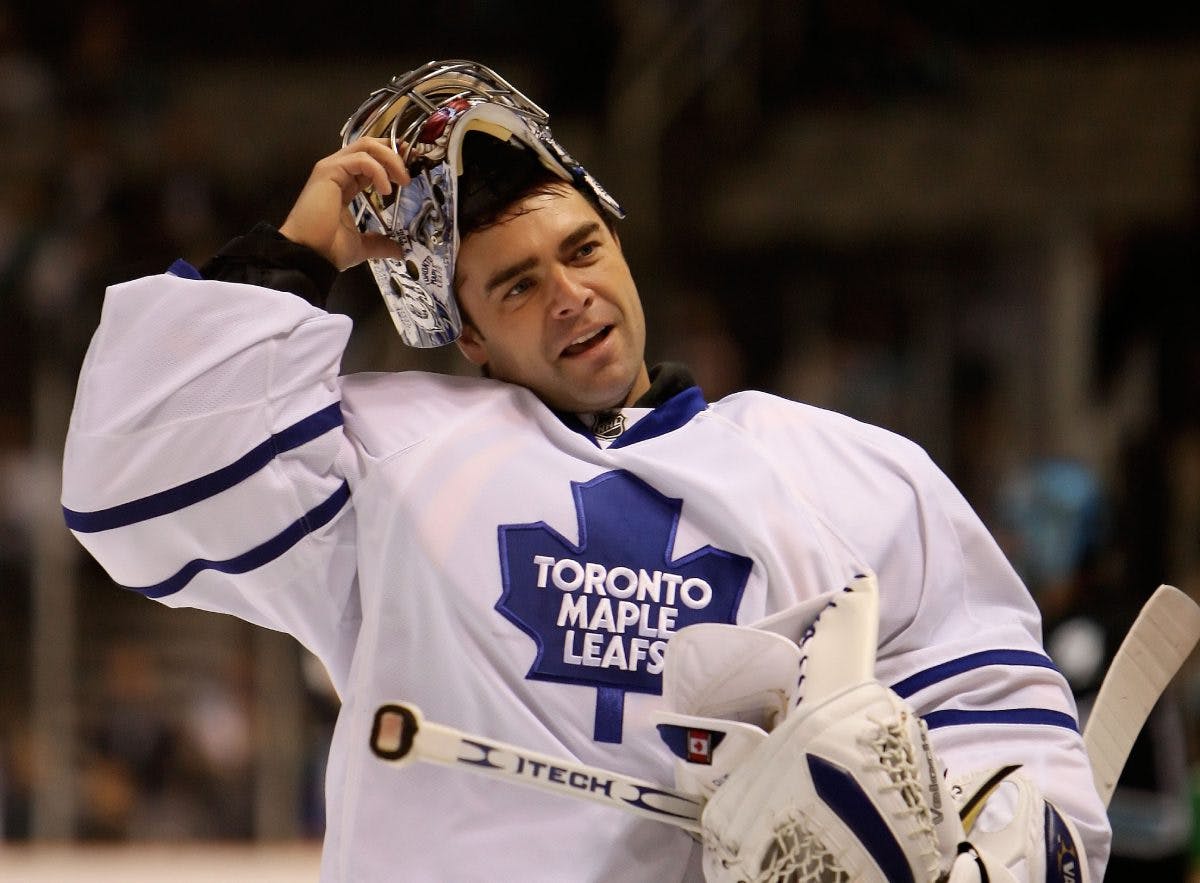
On the lead up to the Hockey Hall of Fame’s announcement of the 2023 Class on Wednesday, June 21, we’ll be profiling eight hopeful candidates. Each player profile will help answer a hard-hitting question about the HHOF and what membership to the game’s most exclusive honor should look like.
Acrobatic saves. Fun gear. Quirky routines. Goaltenders are solemn guardians, banished to a crease in solitude, ready to extend every fiber of their being to protect their net.
As hockey fans, we’re into goalies. We instinctively swipe right. The Hockey Hall of Fame, well, they’ve swiped left a lot over the years. Cute mask, sure, but they just don’t see themselves and goalies together.
Incredibly, there are only 13 NHL goalies in the HHOF that played principally after the 1967 expansion. Thirteen. There’s been 15 Winter Olympics in the same time frame. It’s more common for an NHL goalie to score a goal than get elected — that’s happened 16 times. Featuring long-time holdover Curtis Joseph, today we’re asking why the HHOF is so hard on our masked men.
The Narratives 🎙️
- Big Proponent: “A superstar in three cities, owner of five top-5 Vezina finishes, and having retired with the 4th most wins all-time (454), Cujo was a dynamic, durable sensation long overdue for induction.”
- Big Opponent: “No Stanley Cup, no Vezina, no international gold as a starter, Joseph’s career is a classic case of very good for very long, but short of the Hall’s elite goaltending fraternity.”
The Stats 💻
- NHL Career (1990-2009): 19 seasons — St. Louis, Edmonton, Toronto (x2), Detroit, Phoenix, Calgary
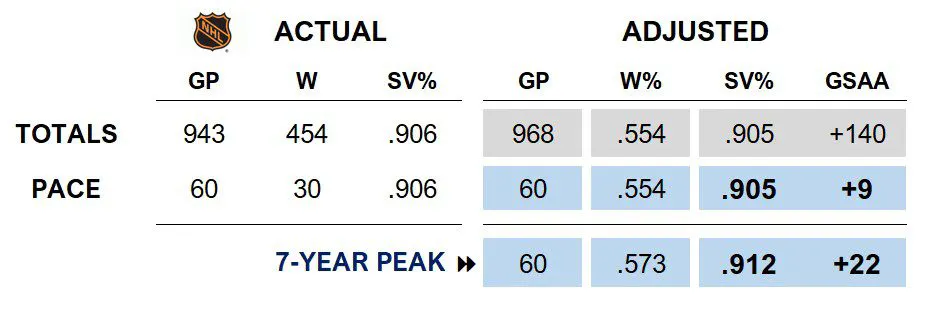
The High Noon Card 🕛
High Noon rankings are the equivalent of the world golf or tennis rankings — only for hockey. A player’s High Noon answers the question: “Where did they rank at their best in the NHL at their position?”
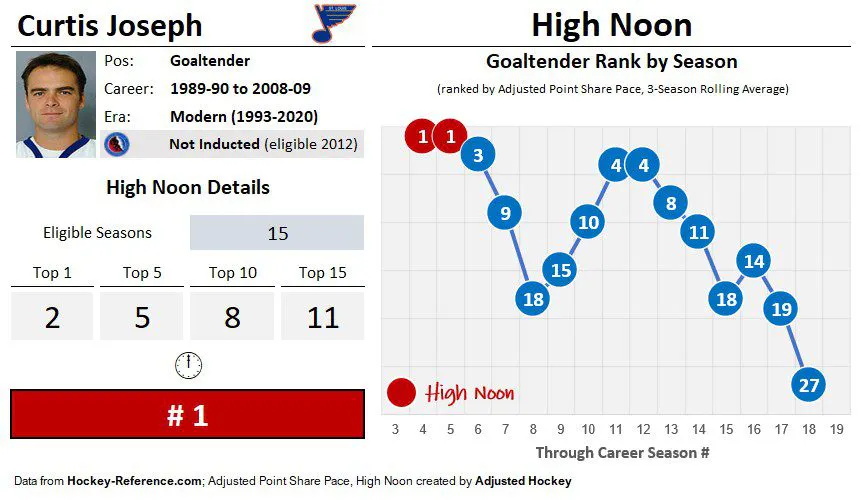
Absent a Vezina Trophy, Joseph can get dismissed as someone never atop the sport. But High Noon shines a spotlight on the true heights the Keswick-born goalie reached. Back when goals against average was still the rage, Cujo was dominating on middle-of-the-pack teams in St. Louis. He was also getting absolutely peppered, leading the NHL in saves his first three years as a starter.
From 1991-92 to 1993-94, Joseph stopped 138 goals above league average — 24 more than anyone else. It was during this time he ranked as the NHL’s #1 goalie in High Noon twice. After famed hockey lunatic Mike Keenan moved on from him, Joseph was off to Edmonton. Despite two stolen first round playoff series and a fifth-place Vezina nod there, he’d see his ranking temporarily drop off on mediocre Oiler outfits. But under the bright lights of Toronto, Cujo’s stock soared again. Returning to #4 in High Noon, he was a two-time Vezina finalist in blue and white, including a prestigious 4th-place MVP showing.
The only goalie to win 30 games with five franchises, the even-keeled Joseph managed to be the star attraction of a traveling circus in a career with multiple high-wire acts. All said, Cujo spent time as the NHL’s best goalie statistically, while lasting 14 consecutive years in the top 20.
The PPS Card 📊
The Pidutti Point Share (PPS) system measures a player’s HHOF worthiness in a single comprehensive number. A player’s PPS score is tiered based on the HHOF standard for their position and era.
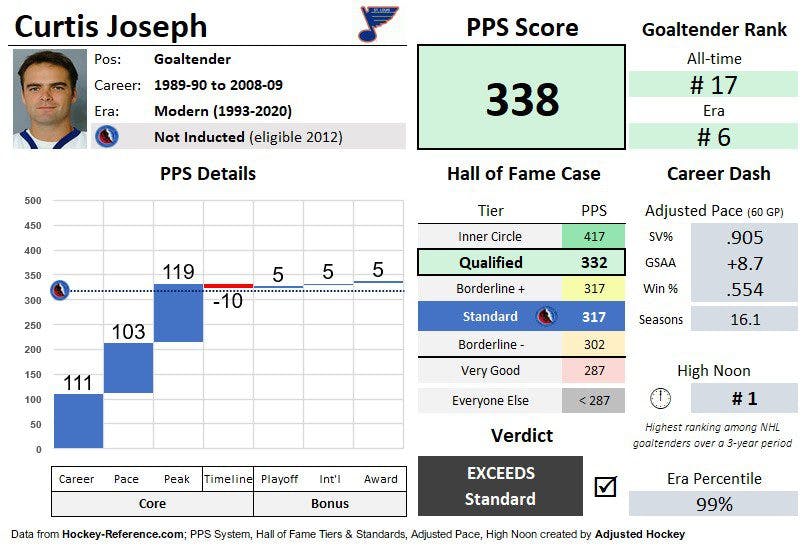
It’s no secret that the PPS system has Cujo posters still up in its room. When the concept was first launched on Daily Faceoff, one of the hot takeaways was that Joseph rated comparably to Henrik Lundqvist, a likely 2023 first ballot inductee. Let’s dive into what makes Cujo’s candidacy pop.
Despite going undrafted, Joseph lasted 19 seasons, his career ending weeks before his 42nd birthday. Sustaining a high level for so long, his Career score (111) trails only Patrick Roy, Roberto Luongo, Martin Brodeur, and Tony Esposito among the 13 post-expansion HHOF goalies. By Pace score (103), he’d rank eighth between Billy Smith and Ed Belfour, solid given his uber-long career. His best seven-year stretch, captured via Peak score (119) is average among HHOF goalies; if curious, Dominik Hasek leads Peak with a preposterous score of 148.
Cujo already exceeds the obscenely high goalie standard of 317 before bonuses. With minimal team success, he doesn’t get much help with his legacy in PPS. He gets only +5 for post-season work, having made multiple final fours as a starter. Joseph’s 63 playoff wins are quietly still 14th all-time — most among goalies without a Stanley Cup.
When it comes to international best-on-bests, Joseph saw action twice, a laudable feat given Canadians ruled the puck stopping roost in his prime. He earns his +5 bonus not from the ’02 Olympic gold (he played a single game), but for his solid showing as a ’96 World Cup finalist. For award bonuses, his Vezina shares get him +5.1, a victim of brutal timing with Roy, Hasek, and Brodeur owning the trophy.
Mash it together and Cujo’s PPS of 338 in on cruise control. He’s in Qualified territory, the only eligible goalie overlooked in the tier.
The Comparisons 🧬
Who a player profiles most similarly to statistically is revealing as it removes any influence from reputation or playing style. Using career length, adjusted scoring, and the core factors of PPS, a player’s top five matches are presented. 1,000 is a perfect match.

A terrific sign in statistical profiles is when your closest matches all top the HHOF standard. Let’s dive into this talented group:
- Vanbiesbrouck (328): With nine top-10 Vezina finishes, including a win, The Beezer had a HHOF career. On the ice, anyway. Having used a racial slur while coaching in his first year after retirement, his case has not been seriously considered publicly, a direct consequence of his actions.
- Lundqvist (344): While the fashionable Swede authored a more consistent career, the margin is thin.
- Belfour (317): While the Hall of Famer was winning Vezinas on defensively dominant Chicago teams, Cujo provided more value in St. Louis under the radar.
- Fleury (319) and Price (318): With the end in sight, these salary cap era stars are generally regarded as future HHOF locks. Cujo rates comfortably above both.
The Answer ⚖️
Why is the Hockey Hall of Fame so tough on goaltenders?
Post-expansion HHOF membership features 99 players elected for their NHL careers. 61 forwards. 25 defensemen. 13 goaltenders. When we consider the basic split on the ice, we’d expect some semblance of a mix of 3/2/1 by position. Extending this logic to the HHOF, forwards are overrepresented to the extreme. The post-expansion membership is uneven as follows: forwards (+12), defensemen (-8), goalies (-4).
The HHOF split need not be in perfect balance. But it’s clear the Hall has greatly favored forwards for decades. Exhibit A: in 14 cycles from 1989 to 2002, there was one NHL goaltender inducted (Smith). In that period, 29 forwards and six defensemen got the call. You don’t need to be Joe Bowen to shout “Holy Mackinaw!” here.
When a slice of a population is so underrepresented, we look to the underlying system, in this case the Selection Committee. Since 1980, of the 34 former players on the Committee, just two have been goalies — Emile Francis (1990-2008) and John Davidson (1999-2021). The lack of goaltenders is puzzling. Human nature is to lean on what you know, and the Committee’s players have known how to score goals, not prevent them.
The present day Selection Committee of 18 breaks down as follows: 10 former players, four executives, four media. All 10 players played the majority of their careers at forward. From a governance perspective, goaltenders and defensemen have been on the sidelines. While there’s no way to know for sure, the HHOF’s obsession with forwards the last five decades can at least plausibly be explained by the composition of its voting body.
Committee demographics aside, which holdover should be elected next?
For the first time, we’re pulling back the curtain and a complete PPS leaderboard is revealed. Below are the tiered PPS rankings for eligible post-expansion goalies. It’s a fun list.
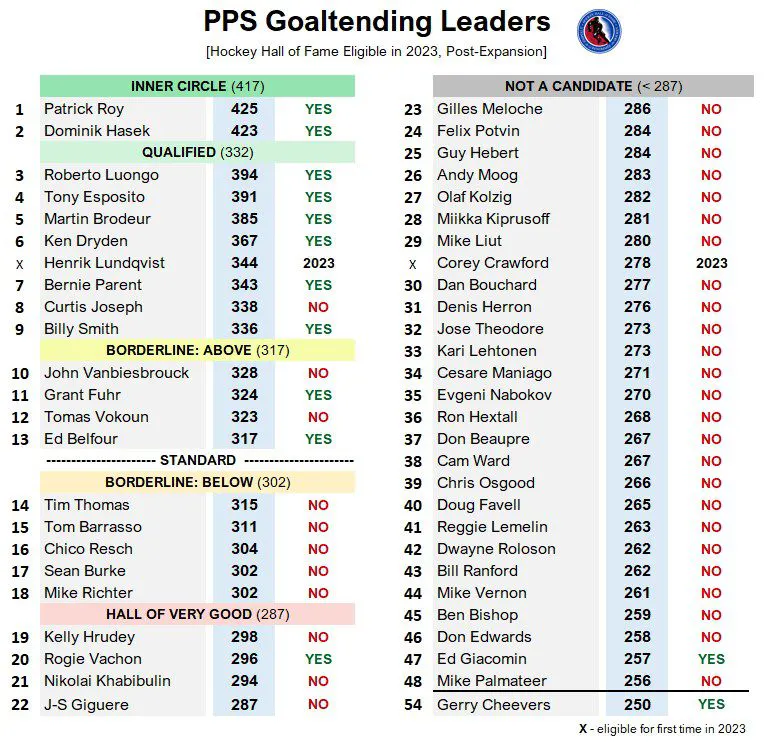
Let the debates begin.
The PPS standard is set based on how many players are elected (13), meaning it’s absurdly high. If Lundqvist is rightfully elected in 2023, the standard will stay at 317. If he’s not, it rises to 323, meaning Belfour will drop below the standard. If the HHOF were electing goalies proportionate to position, we’d have 17 members through 2023, including Lundqvist. This would open the conversation for many other great goalies, one we’ll have below.
The Verdict 🚦
There is a groomsman-but-never-a groom feel to Cujo. But not having played on a true championship-level team until his mid-30s with Detroit is hardly his fault. With Luongo and presumably Lundqvist paving the way for no-Cup goalies, Cujo’s time is now.
We know the HHOF is light between the pipes. Working from the PPS leaders above, let’s check the field.
If not Cujo, then who? We’ll assume Vanbiesbrouck is not getting in soon, if ever. Vokoun is astoundingly underrated, but let’s be honest, his career did not move the needle. Thomas? With two Vezinas and a Smythe, he’s an excellent candidate. But short of the incomparable Ken Dryden, no one has been elected with a career that brief (426 games). Chico Resch? Not making 50+ starts until age 33 limits an overlooked case. Oft-mentioned multiple Cup winners Chris Osgood and Mike Vernon are way down the list. Osgood (.8995) and Vernon (.898) have adjusted save percentages a tick below league average (.900), making their candidacies reputational from team success.
When you strip it down, the most viable candidates over full careers are Joseph and Barrasso. With a PPS of 311, a Vezina and two Cups over 19 seasons, Barrasso remains a first-rate choice. His famously icy personality may have left him in the cold, but he belongs.
Thus, we arrive at Cujo. Long, successful career. Multiple runs among the NHL’s best. Seventh in regular season wins, plus 63 playoff wins. Regular top-ballot Vezina chops. International best-on-best calls. If it matters to you, he rose from childhood poverty to thrive as a late bloomer, earning a Clancy Trophy for leadership and humanitarian contributions in the community. A beloved athlete, he checks the fluffy “fame” box.
In Twitter polling last month, he was the overwhelming choice.
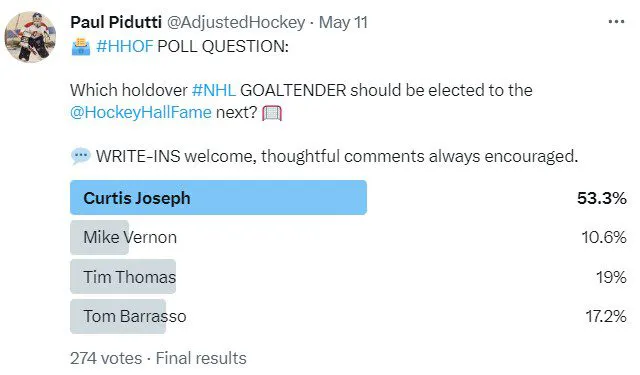
Goaltenders are underrepresented when it comes to hockey immortality. So, it’s long overdue to recalibrate the Hall’s puck stopping standard.
Cujo would make a fine choice.
Catch up on the series by @AdjustedHockey:
- Should six outstanding seasons get a player into the Hockey Hall of Fame? Featuring John LeClair
- Do post-playing careers affect our view of HHOF cases? Featuring Rod Brind’Amour
- How important should team playoff success be to a Hockey Hall of Fame case? Featuring Henrik Zetterberg
Adjusted Pace, High Noon, PPS System, High Noon & PPS Player Cards, Player Comparison Tool from Adjusted Hockey; All other data from Hockey-Reference.com
More from Paul Pidutti
- Generational Talent Watch: Schaefer, Celebrini, Bedard and Carlsson producing at historic levels
- Father Time 2025: Are McDavid, Binnington and others on the decline?
- Surprise: great players rarely make great NHL coaches
- Overtime, loser points unleashing chaos in NHL’s Season of Parity
- Projecting the 2026 Hall of Fame Class: Bergeron, Price and endless possibilities